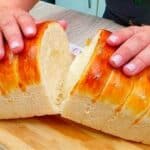Description
Goldbraune Kruste, innen herrlich fluffig und saftig: Dieses Buttermilchbrot duftet verführerisch, schmeckt fein-säuerlich und zart buttrig. Warm gebacken, ist es außen knusprig, innen locker und unwiderstehlich weich.
Ingredients
Scale
- 30 g fresh yeast
- 1 teaspoon sugar
- 320 ml buttermilk, lukewarm
- 50 g butter
- 1 teaspoon salt
- 550 g flour
- Fat for greasing the loaf pan
Instructions
- Begin by preparing the yeast mixture. In a small bowl, crumble the fresh yeast and add 1 teaspoon of sugar. Pour in a small amount of the lukewarm buttermilk—just enough to dissolve the yeast and sugar. Stir the mixture until the yeast is completely dissolved and the mixture is smooth. Let this sit in a warm place for 10 to 15 minutes, or until the mixture becomes slightly frothy and bubbly, indicating the yeast is activated.
- While the yeast is activating, pour the remaining lukewarm buttermilk into a separate bowl or saucepan. Add the butter and salt to the buttermilk. Stir the mixture until the butter is melted and the salt is fully dissolved. If necessary, gently warm the mixture to help the butter melt, but ensure it does not become too hot, as this can kill the yeast.
- Place the flour in a large mixing bowl and create a well in the center. Pour the activated yeast mixture and the buttermilk-butter mixture into the well. Using a wooden spoon or your hands, gradually incorporate the flour from the edges into the liquid until a dough begins to form.
- Knead the dough thoroughly, either in the bowl or on a lightly floured surface. Continue kneading for about 8 to 10 minutes until the dough is smooth, elastic, and no longer sticky. If the dough is too sticky, add a little extra flour, one tablespoon at a time, until it reaches the desired consistency.
- Cover the dough with a clean kitchen towel or plastic wrap and let it rise in a warm, draft-free place for 30 to 40 minutes, or until doubled in size.
- After the first rise, punch down the dough to release any air bubbles. Knead the dough again briefly for 1 to 2 minutes. If the dough is still sticky, add a small amount of flour as needed. Shape the dough into a loaf that will fit your loaf pan.
- Grease a loaf pan generously with butter or oil to prevent the bread from sticking. Place the shaped dough into the prepared loaf pan. Cover it again and allow it to rise for a second time in a warm place until it has noticeably increased in volume, about 20 to 30 minutes.
- Preheat your oven to 210°C (410°F) using top and bottom heat (Ober-/Unterhitze). Once the dough has risen, place the loaf pan on the lowest rack of the preheated oven.
- Bake the bread for 40 to 50 minutes, or until the top is golden brown and the loaf sounds hollow when tapped. If the top browns too quickly, you can cover it loosely with aluminum foil during the last 10 to 15 minutes of baking.
- Remove the bread from the oven and let it cool in the pan for about 10 minutes. Then, carefully turn the loaf out onto a wire rack to cool completely. For best enjoyment, slice and serve the bread while it is still warm.
Notes
For even better flavor, you can let the dough rise for longer during the first proof. Feel free to add seeds or grains to the dough for extra texture. This bread is delicious when served warm with a pat of butter or your favorite spread. If using dry yeast instead of fresh yeast, use one packet (about 7 g) and adjust the activation time as needed.
- Prep Time: 10
- Cook Time: 20
- Category: Brot Rezepte
Nutrition
- Serving Size: 2 Portionen
- Calories: 350-450
- Sugar: 11-16g
- Sodium: 500-800mg
- Fat: 17-25g
- Saturated Fat: 7-11g
- Carbohydrates: 40-50g
- Fiber: 2-5g
- Protein: 15-25g
- Cholesterol: 60-100mg
